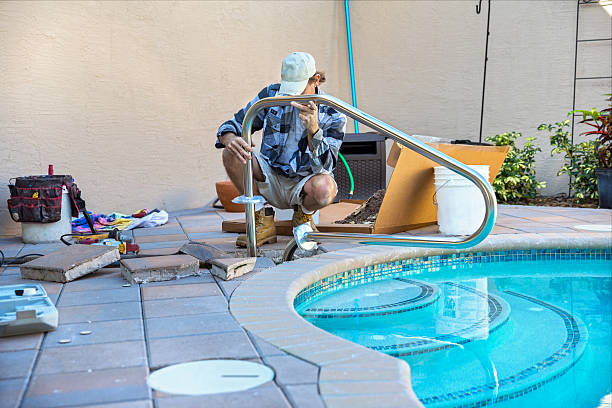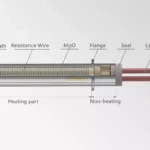Creating your own backyard haven is a rewarding and exciting experience that can offer you, your loved ones, and your guests many years of enjoyment. Whether you’re looking to stay energetic with low-impact exercise, beat the heat during hot summer days, or add a functional and beautiful feature to your property, a pool is an ideal addition to your backyard.
Building a swimming facility can be tasking, with numerous options and factors to consider. This article will walk you through the DIY Pools process. It will offer you expert advice to help you build the perfect swimming bath for your budget and needs.

Materials Used for Building Pools
1. Acrylic Pools
Acrylic pools are beautiful works of art made from acrylic; they are transparent and have a spectacular underwater view. Building an acrylic swimming bath can be expensive, but it’s luxurious and offers excellent durability.
2. Concrete Pools
It’s one of the most popular, and as its name suggests, this pool is built with a mixture of sand and concrete on a steel framework. Concrete swimming baths are customizable and highly durable; you can build them above or in the ground. To complete building a concrete pool takes up to 2-3 months, but the advantage is that it can last for a lifetime.
3. Vinyl-Lined Pools
This pool is prefabricated with an aluminum or steel frame and then covered with vinyl lining. Building this structure is cost-effective, but it offers low durability and will require change every 6-14 years.
4. Fiberglass Pools
The pool variant is prefabricated from fiberglass. You can transport it to your chosen location or shape it on your site. It has a limited shape, design, and size and comes with a few perks, including:
- Budget-friendly
- Easy installation
- Smoother finish

Types of Swimming Pools
Before you commence with your building project, it’s essential to weigh your alternatives for in-ground, customized, or above-ground pools. It’s also important to know that not all swimming facilities are legal in every area. There are diverse types, each with drawbacks and perks.
1. In-Ground Pools
They are permanent edifices built directly into the landscape. In-ground swimming structures come in numerous varieties, such as vinyl-liner, concrete, and fiberglass.
Materials for in-ground swimming baths are selected for their flexibility and strength. You can hire a reputable pool construction company to help you choose your construction.
2. Above-Ground Pools
It’s one of the most inexpensive options. It sits beautifully on the surface of your yard, sometimes with a patio or deck surrounding it. Some above-ground structures have vinyl liners with resin, steel sidings, or aluminum. Pattern walls are also available.
3. Lap Pools
If exercise is your primary motivation for building a swimming facility, then the lap pool is an excellent investment. It’s a specific in-ground variant, usually long, thin, and rectangular, so that users can complete laps efficiently. Lap pools are perfect for areas with small backyards as they are space efficient.
4. Infinity Pools
These structures are typically custom-made to highlight a beautiful view with a vanishing edge design that sits just beneath the water level. This allows the water to flow smoothly over the wall, creating the illusion that the water facility has no restrictions.

Steps to Building Your Own Pool
1. Plan
The first thing that should be on your list is procuring the necessary building permits. The city you live in might require a residential building permit to install a swimming bath on your property. In some states, you can apply for a residential building permit directly on the website of your local department of building & safety.
In addition to permitting, you to build a pool, the permit will also outline the specifications and precise requirements for your new swimming structure. There may be local or state guidelines you must follow, like the distance your pool will cover from your property line.
Another factor to plan is the structure’s design, as it’s critical to the overall aesthetics you want to achieve and what you want to do in the swimming facility. Would you prefer a round, rectangular, or square shape? What’s the depth? How many exits and entrances will the swimming bath have? All these are vital details you must carefully think about.
Swimming facilities with rectangular designs are excellent for individuals who want a timeless and classic look. They’re also perfect for swimming laps and games. Also, free-form structures can blend with the surrounding vegetation and look more natural. Most pools come in standardized sizes, such as
- 10 feet (3.0m) x 20 feet (6.1m)
- 15 feet (4.6m) x 30 feet (9.1m)
- 20 feet (6.1m) x 40 feet (12m)
- 4-15 feet (1.2-4.6m) deep
Remember that the more intricate the pool’s design, the higher the cost.
2. Choose a Suitable Site for the Pool
Designate an area in your property that would be best for your new pool. Pools are typically located in the backyards of many homes, although you can choose to situate yours anywhere, especially if you have enough space.
Installing a pool in most areas requires removing or adding structural features like sections of fencing or trees, which can drive up the cost of your swimming bath project. In addition, ensure the excavation equipment has easy access to the area you want to dig the pool. Visit https://www.bhg.com/home-improvement/outdoor/pools-spas/planning-for-a-pool/ for additional information.
3. Create the Pool’s Foundation
Concrete is used to build a long-lasting foundation. Many residential swimming pools are finished using 1 of 3 surfacing materials which are fiberglass, vinyl, or poured concrete.
Concrete is the most durable and most potent, but it can be expensive. It’s considered the ideal choice for large swimming pools. An adequately maintained concrete pool can add to the resale value of your property.
4. Purchase Molded Fiberglass or Vinyl-Lined
Molded fiberglass is popular for its ease of installation. They are usually sold in their pre-made form, making it a breeze to put in. Fiberglass offers an excellent balance of affordability and durability. For a saltwater swimming bath, you might want to use vinyl lining or fiberglass, as salt can wear away concrete over time.
Vinyl-lined pools are large, smooth sheets shaped to fit the contours of a completed pool. They’re an economical option for finishing a swimming bath. One of its disadvantages is that it wears out faster than concrete and fiberglass.







